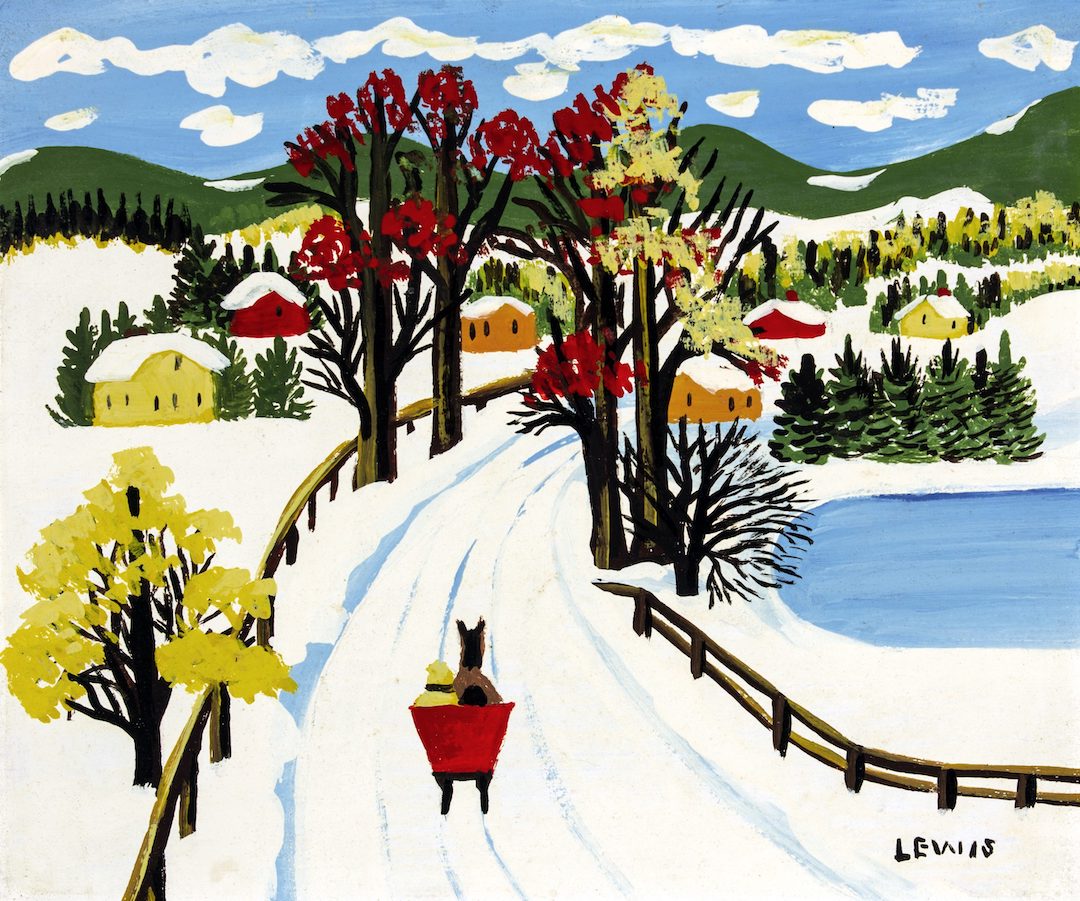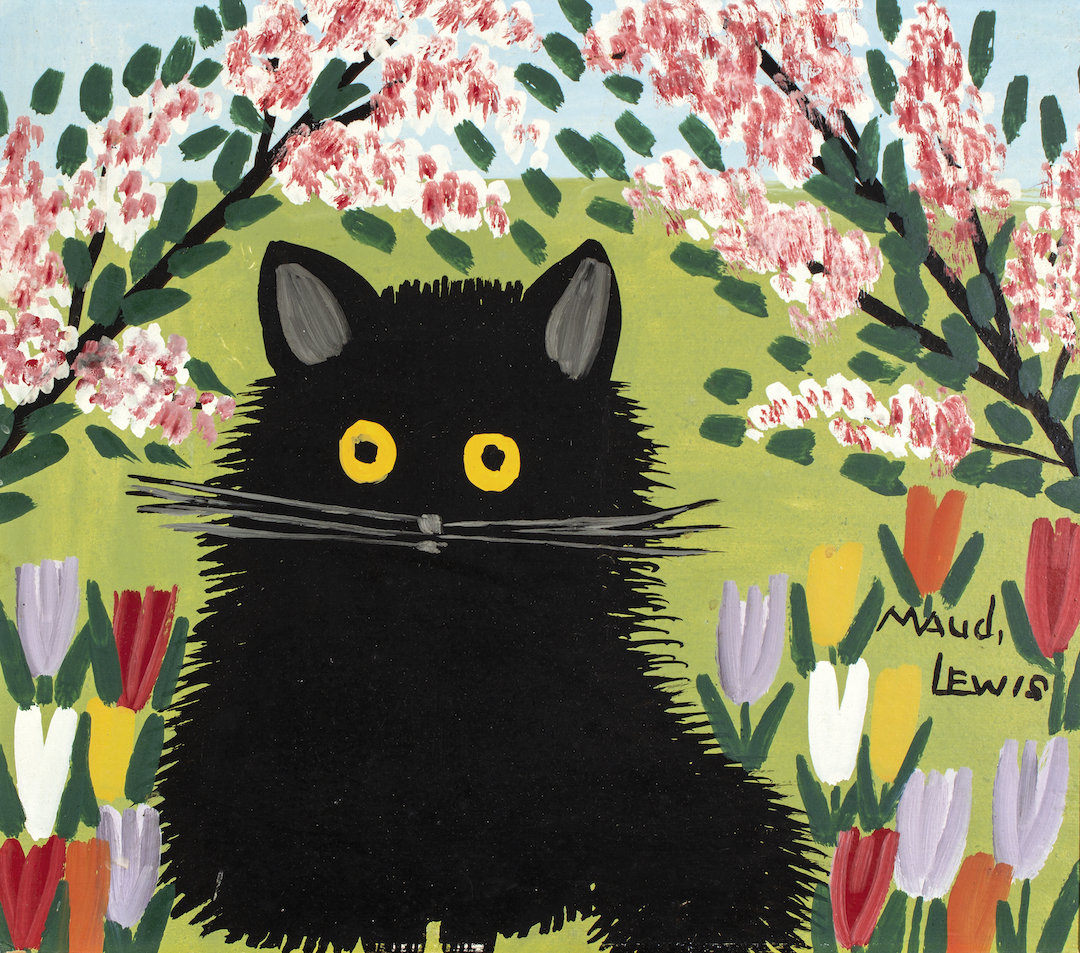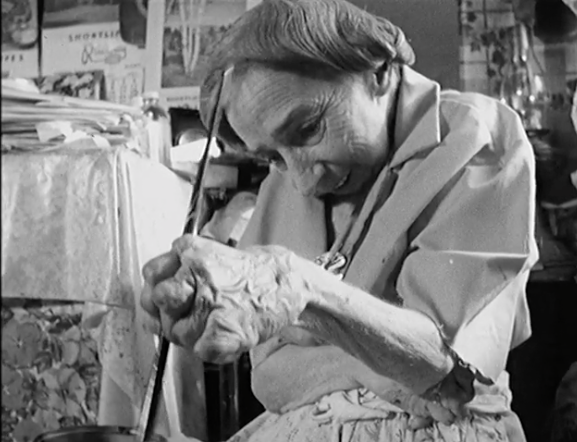[/et_pb_dp_dmb_module_508]

Maud Lewis (1903 - 1970) WINTER SLEIGH RIDE early / mid 1950s Oil on beaverboard (pulpboard) framed: 50.8 × 45.7 cm (20 × 18 in.) Private Collection
Canada’s most beloved folk artist, Maud Lewis (1903–1970) has captured the hearts of many with her dazzling depictions of rural Nova Scotia. Her paintings describe a way of life in the Maritimes that was rapidly changing, as the horse and buggy gave way to the automobileand small-scale net fishing was overtaken by industrial fisheries. Her works are thus both documentary and deeply nostalgic.
Born Maud Dowley, Lewis was raised in the town of Yarmouth, Nova Scotia, the daughter of a blacksmith. Until her final days, she would revisit in her paintings the happy scenes of her childhood, depicting as well the birds and animals remembered from that time. Hers was an art of unbridled joy, despite the many harrowing setbacks she faced: her rheumatoid arthritis, which worsened as she progressed toward adulthood; the early deaths of her parents; the loss of her baby daughter born out of wedlock (and placed secretly with another family by Lewis’s father); and the difficulties of her later marriage. Her desire to make art was the driving force in her life.
Lewis had an instinctive gift for colour and composition, and she put that gift to remarkable use in her variations on set themes—from cats and kittens, to covered bridges, to her scenes of boats in harbour. We have gathered several of these series together, the better to understand her vision and appreciate the exuberant creativity she brought to the art of painting. Lewis sold the paintings from her little house at the side of the road at Marshalltown, NS, where she lived with her husband, Everett, from 1938 until her death in 1970, leaving through her work a legacy of irrepressible delight.

Maud Lewis (1903 - 1970) UNTITLED (Black Cat with Tulips and Apple Blossoms) c. 1962 Oil on board 34 × 37.5 cm (13 3/8 × 14 3/4 in.) Private Collection - Nova Scotia
Join Sarah Milroy, chief curator of McMichael Canadian Art Collection for a curatorial talk on the life and works of celebrated folk artist Maud Lewis.
Watch MAUDIE (2016) a biographical drama about the life of Canadian folk artist Maud Lewis. This film is a co-production of Ireland and Canada, and was directed by Aisling Walsh and stars Sally Hawkins and Ethan Hawke.
https://gem.cbc.ca/media/films/maudie/38e815a-0119a340d20
Enjoy this National Film Board Documentary: Maud Lewis: A World Without Shadows
Diane Beaudry 1976 | 10 min
Set against a background of her paintings and the Yarmouth, Nova Scotia, landscapes they depict, this short documentary is a portrait of the life and work of one of Canada's foremost primitive painters, Maud Lewis. Emerging from her youth crippled with arthritis, Lewis escaped into her painting at the age of 30. She had never seen a work of art and had never attended an art class but her paintings captured the simple strength, beauty and happiness of the world she saw - a world without shadows.
Get a glimpse of the real lives of Maud and Everett Lewis as recorded by CBC in 1965 "Folk artist Maud Lewis at work in her Nova Scotia home".
https://www.cbc.ca/player/play/761637443808
Maud Lewis (1903 - 1970) SLEIGHS AND RED COVERED BRIDGE Oil on board 25.4 × 33 cm Collection of CFFI Ventures Inc. as collected by John Risley
This exhibition was organized and circulated by the McMichael Canadian Art Collection and curated by Sarah Milroy, Chief Curator.

Presenting Sponsors
Bryce and Nicki Douglas
Susan Glass and Arni Thorsteinson
Lead Sponsors


Exhibition Contributors


Tim's Paint & Trim
All images on this page © Art Gallery of Nova Scotia
Did you know?
Kenora was once claimed by Ontario and by Manitoba. Both provinces claimed the area between 1878 and 1884. The case was resolved in 1884 by Queen Victoria’s Privy Council, the highest court in the world at the time.



